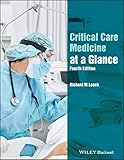Critical care medicine at a glance / Richard M. Leach.
By: Leach, Richard M. (Haematologist) [author.]
Language: English Series: At a glance series (Oxford, England): Publisher: Chichester, West Sussex, UK ; Hoboken, NJ : Wiley-Blackwell, 2023Edition: Fourth editionDescription: xix, 185 pages : color illustrations; 28 cmContent type: text Media type: unmediated Carrier type: volumeISBN: 9781119605867Subject(s): Critical Care -- methodsGenre/Form: HandbookAdditional physical formats: Online version:: Critical care medicine at a glanceDDC classification: 616.02/8 LOC classification: RC86.7| Item type | Current location | Home library | Call number | Status | Date due | Barcode | Item holds |
|---|---|---|---|---|---|---|---|
 BOOK
BOOK
|
COLLEGE LIBRARY | COLLEGE LIBRARY SUBJECT REFERENCE | 616.028 L468 2023 (Browse shelf) | Available | CITU-CL-53949 |
Includes index.
Table of Contents
Preface viii
Acknowledgements ix
Units, symbols and abbreviations x
How to use your textbook xvi
Part 1 General 1
1 Recognising the unwell patient 2
2 Managing the critically ill patient 4
3 Monitoring in critical care medicine 6
4 The electrocardiogram 8
5 Cardiopulmonary resuscitation 10
6 Oxygen transport 12
7 Shock 14
8 Circulatory assessment 16
9 Fluid management: pathophysiological factors 18
10 Fluid management: assessment and prescription 20
11 Fluid management: fluid choice 22
12 Inotropes and vasopressors 23
13 Failure of oxygenation and respiratory failure 24
14 Oxygenation and oxygen therapy 26
15 Airways obstruction and management 28
16 Non- invasive ventilation 30
17 Endotracheal intubation 32
18 Mechanical ventilation 34
19 Extracorporeal membrane oxygenation 36
20 Respiratory management, weaning and tracheostomy 38
21 Arterial blood gases and acid–base balance 40
22 Analgesia, sedation and paralysis 42
23 Enteral and parenteral nutrition 44
24 Hypothermia and hyperthermia 46
25 Assessment of the patient with suspected infection 48
26 Sepsis and septic shock 50
27 Hospital- acquired (nosocomial) infections 52
28 Fever in the returning traveller 54
29 Fever (pyrexia) of unknown origin 56
30 Coronavirus disease 2019 58
31 End of life issues 60
Part 2 Medical 63
Cardiac
32 Acute coronary syndromes I: clinical pathophysiology 64
33 Acute coronary syndromes II: investigations and management 66
34 Arrhythmias: tachyarrhythmias 68
35 Arrhythmias: bradyarrhythmias 71
36 Heart failure and pulmonary oedema 72
37 Cardiac emergencies 74
38 Deep venous thrombosis and pulmonary embolism 76
Respiratory
39 Chest imaging and bronchoscopy 78
40 Community-acquired pneumonia 80
41 Hospital-acquired (nosocomial) pneumonia 82
42 Asthma 84
43 Chronic obstructive pulmonary disease 86
44 Acute respiratory distress syndrome 88
45 Pneumothorax and air leaks 90
46 Respiratory emergencies 92
Renal and metabolic
47 Acute kidney injury: pathophysiology and clinical aspects 94
48 Acute kidney injury: management and renal replacement therapy 96
49 Electrolyte disturbances: sodium and potassium 98
50 Electrolyte disturbances: calcium 100
51 Electrolyte disturbances: magnesium and phosphate 102
52 Diabetic emergencies 104
53 Endocrine emergencies 106
Gastrointestinal
54 Gastrointestinal haemorrhage 108
55 Jaundice 110
56 Acute liver failure 112
57 Acute pancreatitis 114
58 Vomiting and intestinal obstruction 116
59 Diarrhoea 118
60 Ascites 120
61 Abdominal Imaging 121
Neurological
62 Acute confusional state, coma and status epilepticus 122
63 Stroke 124
64 Other cerebral vascular disorders 126
65 Infective neurological emergencies 127
66 Neuromuscular conditions 128
Infective
67 Specific bacterial infections 130
68 Common adult viral infections 132
69 Common fungal and protozoal infections 134
70 The immune compromised patient 136
Other systems
71 Coagulation disorders and transfusion 138
72 Drug overdose and poisoning 140
73 Dermatology in ICU 142
Part 3 Surgical 145
74 Trauma 146
75 Traumatic brain (head) injury 148
76 Chest trauma 150
77 Acute abdominal emergencies 152
78 Obstetric emergencies 154
79 Burns, toxic inhalation and electrical injuries 156
80 Envenomation, stings and bites 158
Part 4 Self-assessment 161
Case studies and questions 162
Case studies answers 165
Appendices
Appendix I: Sequential (sepsis- related) Organ Failure Assessment (SOFA) score 172
Appendix II: Classification of antiarrhythmic drugs (based on Vaughan Williams classification) 173
Appendix III: Pacemaker types and classifications 174
Appendix IV: Acute Kidney Injury Network (AKIN) staging system for acute kidney injury 175
Appendix V: Rockall risk- scoring system for gastrointestinal bleeds 176
Appendix VI: Child–Pugh grading 177
Appendix VII: Typical criteria for liver transplantation 178
Appendix VIII: Royal College of Physicians’ top nutrition tips 179
Index 180
"Everything you need to know about Critical Care Medicine...at a Glance! Critical Care Medicine at a Glance provides a succinct, accessible, highly illustrated introduction to the care of the critically ill patient. Designed for medical students and junior doctors and nurses alike, this authoritative revision guide covers the essential clinical, diagnostic, and therapeutic skills required to manage critically ill patients with a wide range of conditions in a variety of settings. Colour-coded chapters, each of which are presented on a double-page format, contain concise explanatory text, applications to practice, and numerous high-quality photographs, illustrations, diagrams and tables. Fully revised to reflect current guidelines, changes in practice and recent medical innovations, the fourth edition includes expanded coverage of resus, sepsis, covid-19, ECMO, dermatological emergencies, envenomation and other key conditions and procedures. Updated chapters incorporate current assessment methods used by medical schools and postgraduate training programmes, whilst additional 'Pearls of Wisdom' boxes and Wise Owl Reading' reference suggestions are integrated throughout to aid learning and comprehension"-- Provided by publisher.

There are no comments for this item.